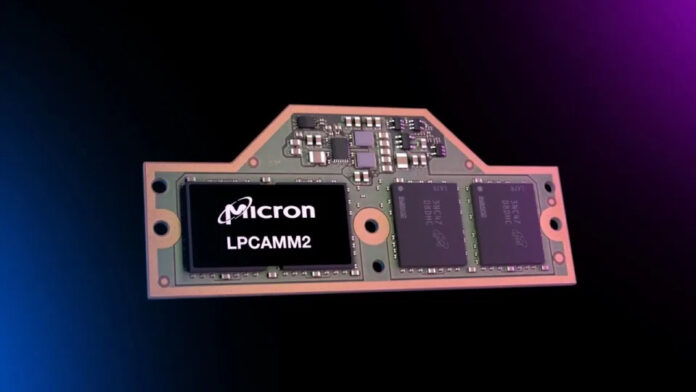Micron has launched a smaller and faster notebook computer memory module that draws less electrical power than the SODIMMs currently used and is plugged, not soldered, onto a motherboard.
This means higher notebook performance, longer battery life, and more component freedom for motherboard designers. The LPCAMM2 (Low Power Compression-Attached Memory Module) is physically smaller than a SODIMM (Small Outline Dual In-line Memory Module) and based on LPDDR5 (Low Power Double Data Rate 5) DRAM. It has a shorter trace to the motherboard than SODIMM because it is compressed against a motherboard connector instead of using soldered pins. The device has dual channels and supports 128 bits.
Praveen Vaidyanathan, VP and GM of Micron’s Compute Products Group, said: “The LPCAMM2 product … will deliver best-in-class performance per watt in a flexible, modular form factor. This first-of-its-kind product will enhance the capabilities of AI-enabled laptops, whose memory capacity can be upgraded as technology and customer needs evolve.”

SODIMMs provide Synchronous Dynamic Random Access Memory (SDRAM) to a host computer. Micron provides 8-128 GB capacity SODIMMs built from 16 Gb to 64 Gb DDR5 SDRAM (Synchronous DRAM) devices with four or eight internal memory bank groups. They have a 4,800-6,400 megatransfers per second (MTps) data rate and can be dual-stacked to increase capacity. Micron’s LPCAMM2 package delivers a 64 percent volume space saving compared to a dual-stacked SODIMM module.

Its data rate is 7,500 MTps compared to current 5,600 MTps SODIMM speeds. Micron says LPCAMM2 speed is expected to increase to 8,500 MTps in 2025, when SODIMMs generally will rise to 6,400 MTps, and 9,600 MTps in 2026 compared to the 7,200 MTps expected from SODIMMs then.
This MTps speed advantage enables faster notebook application speeds. Micron provided PC Mark 10 scores comparing LPCAMM2 to SODIMMs:

Micron provided power consumption comparisons with DDR5 5600 SODIMMs as well:

JEDEC has specified the CAMM2 standard, and we can expect other memory suppliers, such as Samsung, to launch CAMM2 products. We can expect capacities to head towards 128 GB per module and possibly beyond that to 192 GB.
Micron’s LPCAMM2 products allow laptop PC users the ability to upgrade their system memory configuration. LPCAMM2 DRAM uses less power than SODIMMs, provides faster performance, is physically smaller and is upgradeable. What is not to like?
Bootnote
Dell introduced its then-proprietary CAMM technology with its Precision 7670 laptop product in November 2022, and JEDEC then defined its CAMM2 standard based on it, during 2023. The JESD318 CAMM2 standard is available for download from the JEDEC website and CAMM2 could replace SODIMM technology. There is more LPCAMM2 information here and in a Micron blog.








